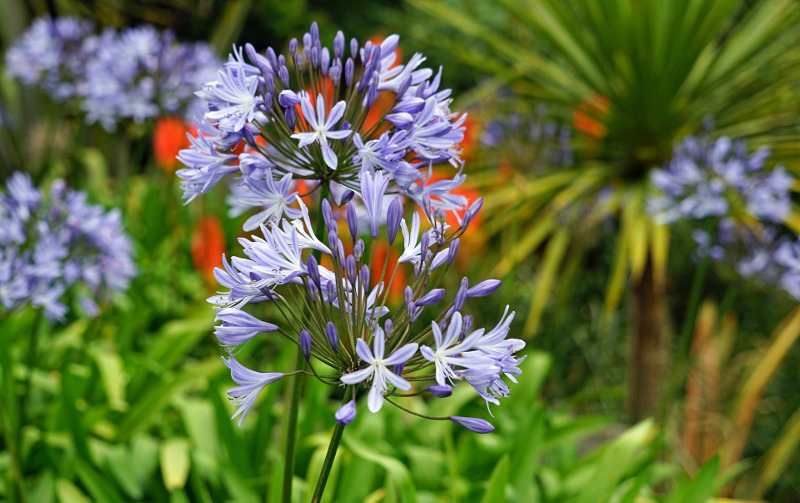Mastering the Art of Agapanthus Treatment: Important Steps for Healthy And Balanced Growth and Lively Blossoms
In the world of cultivation, the growing of agapanthus stands as a gratifying undertaking for those who seek to nurture these stylish flowering plants. From selecting the best range to grasping pruning techniques, the journey in the direction of cultivating flourishing agapanthus plants is multifaceted and holds the key to unlocking the complete capacity of these herb treasures.

Selecting the Right Agapanthus Selection

When selecting the appropriate Agapanthus selection for your yard, think about factors such as environment suitability, blossom color, and growth behavior. In addition, think about the climate in your area to make certain the Agapanthus range you choose can flourish in your details conditions. Understanding the development routine of various Agapanthus selections is vital for appropriate placement within your yard.
Ideal Growing Conditions
Considering the ideal ecological needs is necessary for successful Agapanthus growing. Agapanthus grows in well-draining soil with a somewhat acidic to neutral pH level. When planting, choose a location that receives full sunshine to partial color. In hotter climates, providing some afternoon color can stop scorching of the fallen leaves. Agapanthus plants are sensitive to cold temperature levels and should be shielded from frost throughout winter season.
To ensure healthy and balanced growth and vivid blossoms, plant Agapanthus bulbs at a depth of about 2-4 inches and area them 8-12 inches apart. Mulching around the base of the plants assists keep moisture and subdues weed growth.
Watering and Fertilizing Tips
Keeping correct moisture degrees and providing necessary nutrients are vital aspects in the treatment routine for Agapanthus plants. When it comes to sprinkling Agapanthus, it is important to strike a balance. These plants favor constantly wet dirt but are susceptible to root rot if overwatered.
Feeding Agapanthus is necessary for advertising healthy and balanced growth and prolific blooms. Apply a well balanced plant food, such as a 10-10-10 formula, in the very early springtime as brand-new development emerges. By following these watering and fertilizing tips, you can guarantee your Agapanthus plants thrive and create lively, lasting flowers.
Pruning Strategies for Agapanthus
Pruning Agapanthus plants at the suitable times and with proper techniques is vital for maintaining their health and advertising optimum development and blooming. The ideal time to trim Agapanthus remains in late wintertime or early spring prior to brand-new development emerges. Beginning by removing any kind of dead or yellowing fallen leaves near the base of the plant. Cut them as short as feasible without harming the emerging shoots.
Deadheading invested flowers can also redirect the plant's energy right into producing even more blooms description rather than setting seeds. If you want to collect seeds for propagation, leave some flowers to dry and fully grown on the plant.
Remember to use clean, sharp devices to make precise cuts and decrease the threat of introducing conditions. Agapanthus. Normal trimming will assist keep your Agapanthus looking healthy and neat while making certain a bountiful display screen of beautiful flowers
Taking Care Of Usual Bugs and Conditions
After making certain appropriate trimming techniques for Agapanthus, it is necessary to resolve common bugs and conditions that can impact the wellness and vigor of these plants. Agapanthus plants are generally sturdy however can still succumb particular concerns. One usual parasite that affects Agapanthus More Help is the Agapanthus gall midget. This little, orange fly lays its eggs in the foliage, bring about altered development and flower buds that stop working to open. To combat this pest, trim and ruin any type of damaged plant components and consider utilizing insecticidal soap.
An additional typical concern is fungal leaf area, which offers as dark lesions on the fallen leaves. To stop fungal diseases, make certain good air flow around the plants, avoid above watering, and get rid of any infected leaves without delay. In addition, Agapanthus plants can endure from origin rot if they are planted in poorly draining pipes soil. To avoid this, plant Agapanthus in well-draining dirt and stay clear of overwatering. By being cautious and taking timely action against illness and insects, you can help your Agapanthus plants grow and create vibrant blossoms.

Final Thought
Finally, mastering the art of agapanthus treatment includes selecting the best selection, supplying suitable growing conditions, appropriate watering and fertilizing, ideal pruning strategies, and dealing with common parasites and illness. By following these vital steps, you can make certain healthy and balanced growth and vivid blossoms for your agapanthus plants. Keep in mind to frequently monitor and keep your plants to promote their total health and longevity.
To ensure healthy and balanced growth and dynamic flowers, plant Agapanthus bulbs at a deepness of about 2-4 inches and area them 8-12 inches apart. By adhering to these watering and feeding suggestions, you can ensure your Agapanthus plants flourish and generate lively, lasting blossoms.
One common bug that influences Agapanthus is the Agapanthus gall midge. Furthermore, Agapanthus plants can suffer from root rot if they are planted in visit this web-site poorly draining pipes soil. By adhering to these essential steps, you can make certain healthy and balanced development and vibrant blooms for your agapanthus plants.
Comments on “Stunning Agapanthus: Enhancing Your Yard's Elegance”